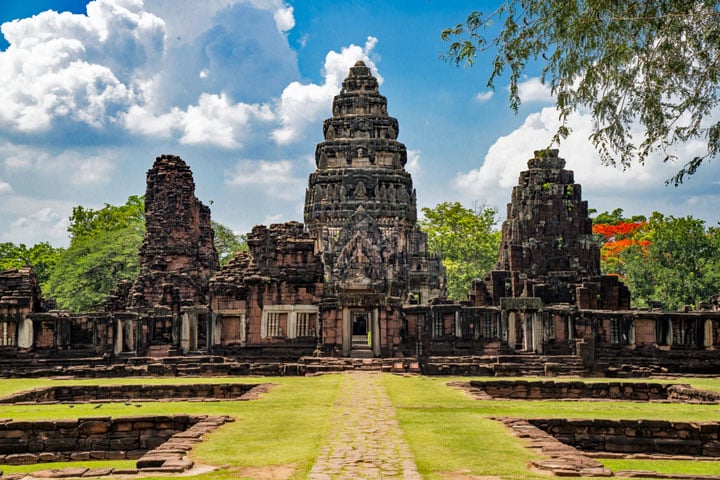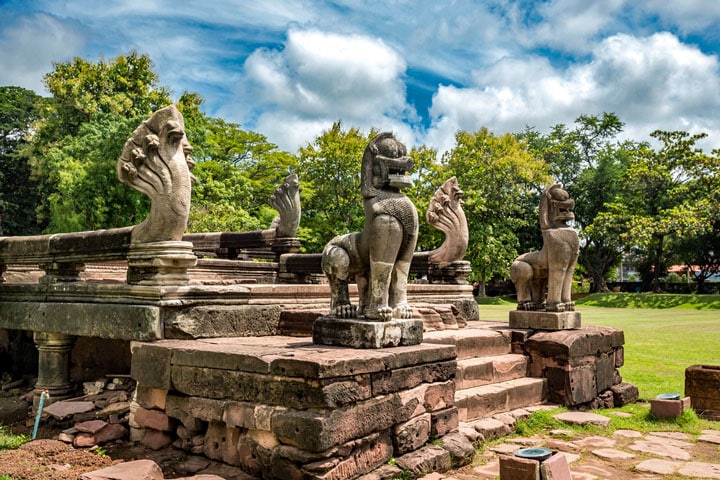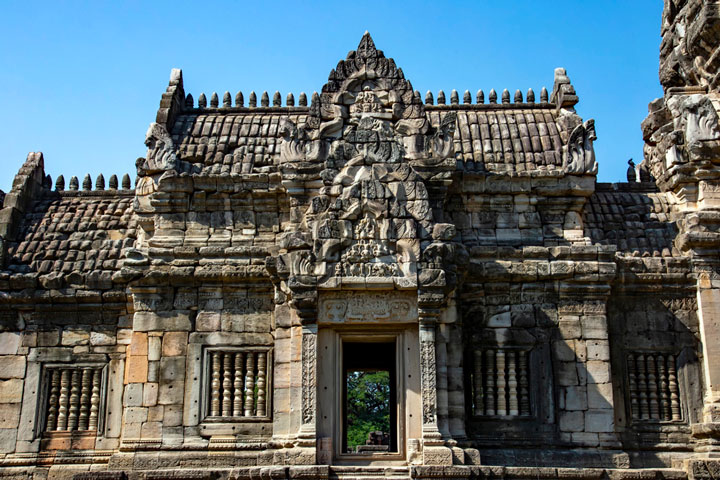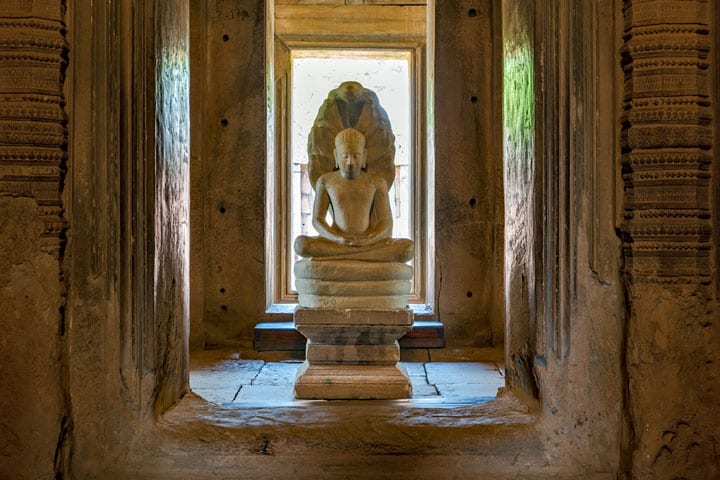Prasat Hin Phimai: the largest Khmer temple in Thailand
During the more than four centuries that the Khmer ruled Isan, they built more than 200 religious or official structures. Prasat Hin Phimai in the heart of the town of the same name on the Mun River in the province of Khorat is one of the most impressive Khmer temple complexes in Thailand.
About the origin of this Temple is not clear but it is now believed that the central shrine was built under the reign of Suryavarman I (1001-1049). The round, 32 meter high central Prang or temple tower is said by some to have inspired the designers of Angkor Wat. And that is plausible because it is believed that Phima was the end point of the main route that departed from Angkor through the Khmer empire. A route that ran through the Dongrek Mountains and across the southern part of the Khorat Plateau. Under the rule of Jayavarman VI (1080-1107), Phimai was perhaps even – briefly – the capital of the Khmer Empire, which underlines the cultural-historical importance of this site. This monarch may have been responsible for the construction of the sandstone outer wall and the southern one Gopura, while his successor Jayavarman VII built the 15-meter-high red sandstone Prang Hin Daeng and the one meter higher laterites Prang Brahmadatta built within the sanctuary.
Prasat Hin Phimai is a curious temple complex in more ways than one. Unlike most other Khmer temples, people are completely in the dark about the origin of this temple. Numerous Sanskrit inscriptions referring to Vimayapura – the city of Vimaya, a name that may be related to a Hindu-Brahamanistic cult and from which the Siamese Phimai would have originated.
It is also the only Khmer temple in Thailand that is predominantly from the time of construction Mahayana Buddhist elements were strongly influenced in terms of characteristics by those originating from India Dvaravati-style. This in itself is not surprising because it is certain that already in the 7e century of our era Buddhism had penetrated to the Khorat plateau. However, recent studies seem to indicate that Brahamanistic and animistic rituals have also taken place in this temple.
The orientation of the building is also a mystery. Most Khmer temples lie on a west-east axis. Phimai was oriented to the south, although this is also not exact because in fact the south recedes Gopura or entrance gate 20° off to southeast. Coincidence or not, but when we draw a straight line from this point, we end up in… Angkor Wat.
Prasat Hin Phimai is the largest Khmer structure in Thailand in terms of area. It is 565 meters wide and 1.030 meters long, rivaling Angkor Wat. Red-brown and white sandstone, the ferruginous laterite and brick were used as the main building materials in Phimai. Archaeological research has shown that the access road is that of the southern one Gopura – which was the main gate – ran to the central part, was once covered. The seven-headed serpents or NagaWith their bodies they form the Naga bridges that symbolize the transcendence of the Earthly to the Divine. Many of the reliefs on the cover and lock stones were inspired by the Ramayana. While the central Prang symbolizing Mount Meru, the inner enclosure wall represents the Earth, while the outer wall that surrounds the entire complex marks the boundaries of the Universe.
The French geographer and explorer Etienne Aymonier (1844-1929), who was the first scientist to systematically map the Khmer heritage in what is now Thailand, Laos, Cambodia and South Vietnam, was the first academic to investigate the dilapidated temple complex in 1901. It was thanks to his pioneering work that Phimai was one of the first archaeological sites to be protected in Thailand. This was done through the publication of the Protection Decree in the Siam Government Gazette on September 27, 1936. Still, it would take decades before the decay was stopped and a radical – according to some even too radical – restoration was carried out. Between 1964 and 1969 the Thai Fine Arts Department under the direction of the French archaeologist Bernard Philippe Groslier carried out the most important restoration. This was followed by conservation and environmental works. The opening in 1989 of the Phimai historical park was the culmination of this work.
The nearby Phimai National Museum, where many of the archaeological finds from the temple complex can be found, has reopened after a major renovation. Opening hours from 09.00 a.m. to 16.00 p.m.






Phimai lends itself to staying an extra day. The Phimai Historical Park is in the middle of the city.
Sai Ngam is 2 km from the center. This 350-year-old sacred banyan tree is Thailand's largest and oldest banyan tree. The tree stands on a densely vegetated island between the Mun River and an old meander of this river. The tree is decorated with garlands and offerings. Opposite the main entrance of the island are several eateries where you can eat delicious and cheap. There are also stalls where the locals buy their flower wreaths. You can browse around yourself between the strangest souvenirs.
The Phimai Paradise Hotel, with swimming pool, is in the center in the side street on the right past the clock tower. Great hotel with elevator. Popular hotel, so reservations recommended. http://www.phimaiparadisehotel.com/ from €14 at Agoda.com. Opposite is a good garden restaurant.
At the clock tower is a real pub with a terrace. The night market also starts there.
Phimai can also be perfectly combined with the Khmer temples of Prasat Muang Tam and Phanom Rung. Traveling around in the real Thailand.
Phimai is a beautiful temple, well worth a visit. Half a day seems enough to me, after all it's not that big (it's certainly not Angkor Wat).
Parking is possible in front of the door. Entrance price is very reasonable. There is also a beautiful garden, where you can sit on a bench under the shade of the trees.
Some books of Etienne Aymonier's work have been translated into English and published by White Lotus: Khmer Heritage in Thailand and Isan Travels: Northeast Thailand's Economy in 1883-1884.
They describe all Khmer temples etc. and the economy and daily life of all settlements in the North-East of Thailand. The 2nd work contains a large number of maps with settlements, roads, watercourses and the like. It is a standard reference for the history of that part of Siam.
https://www.whitelotusbooks.com/search?keyword=Aymonier
Also don't forget that on your way to the Sai Ngam on the right you will find a public building, completely open at the front with four flights of stairs, where Thai women of the city are ready for 'old-fashioned' massages.
As a souvenir, you can also buy herbal pouches wrapped in linen, which the women heat and use to apply pressure to your sore spots. Still really authentic.
A nice gift for the home front. And even my Thai cleaning lady in Belgium was very happy
when I gave her some.
Phimai rightfully boasts that there is neither a beer bar in their town nor barlady's!!! You don't have to stay in Phimai for that.
And they are proud that all residents have a job – no idlers there, that is.
Furthermore, the Thai-Chinese residents-traders provide some ambiance, apart from the Thai initiatives such as the annual famous longboat races on the Lamjakarat, annex Mun and the sober celebration of the Loy Krathong.
You can buy delicious street food at the daily night market. There is also a pastry chef who makes beautiful festive cakes for all birthdays from Phimai.
For love I stayed there several times quite long, and wrote three stories inspired by Phimai, published on Trefpunt Asia ✝︎, but now I have to offer them to Thailandblog. One about the boat races, one about Ploy who lives in Bangkok and is unhappily married to a wealthy Israeli but has a tree in a field that she owns, and one about the mysterious disappearance of a five-year-old Myanmar boy, the child of Burmese guest workers in the sugar cane harvest, which was found raped and murdered in a cane plantation.
Phimai - a sleepy Khmer town with hidden mysteries - that you will not experience during a short passage.